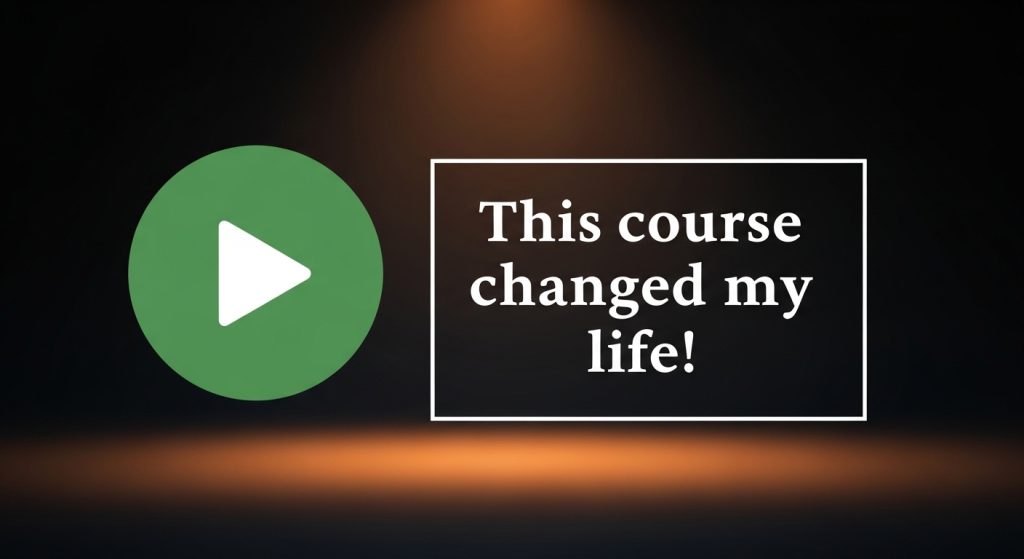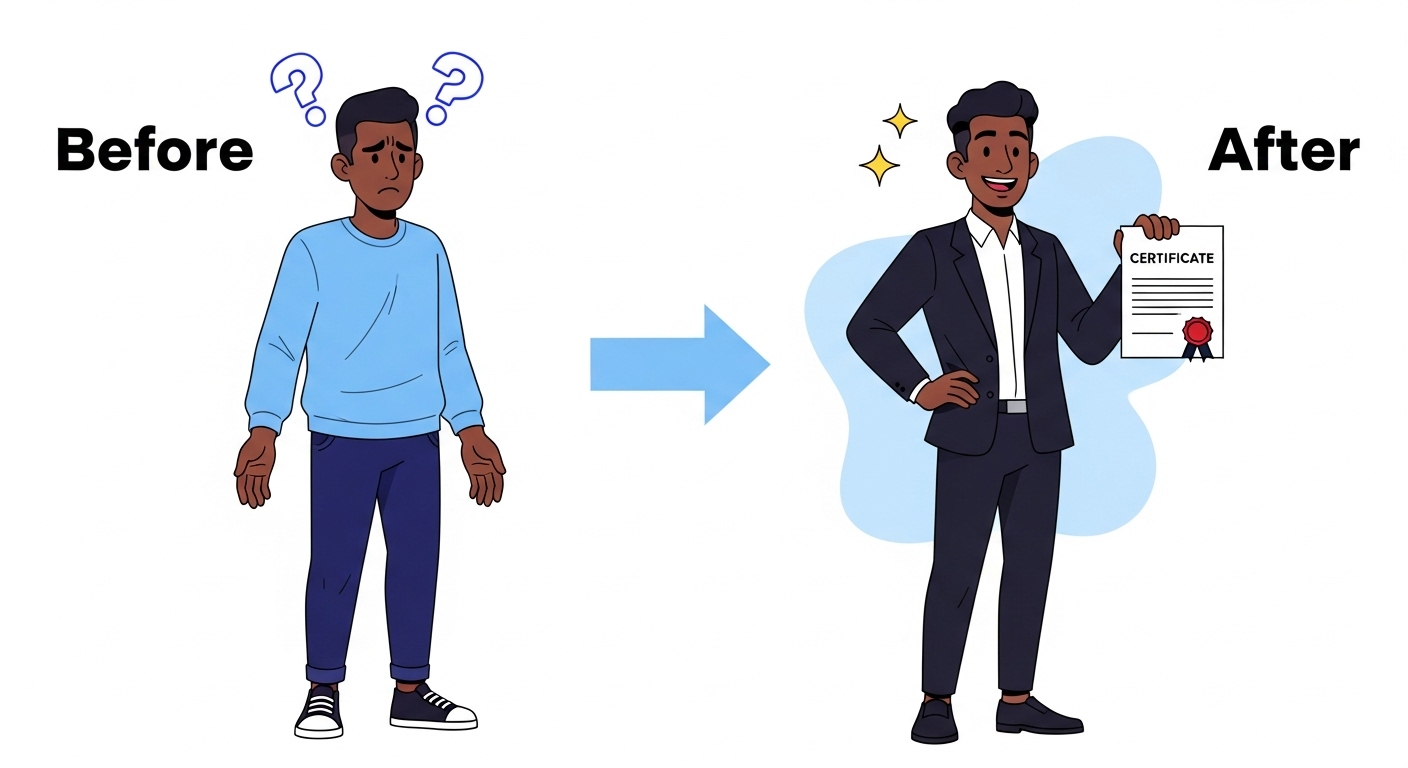It’s a shining time for digital products right now, and online courses are leading the way. But You need to know this, selling a course isn’t just about having good content. It’s about building trust with people who’ve never met you, don’t know much about your work, and are being asked to spend their hard-earned money.
They’re thinking:
- “Will this course help me?”
- “Is this a scam?”
- “Have other people like me gotten real results?”
And that’s where video testimonials come in. Nothing beats seeing and hearing a real person talk about how your course changed their business, boosted their confidence, or helped them land their first paying client.
People can smell overhyped marketing from a mile away. But when someone genuine looks into the camera and says, “I was nervous about buying this course, but it turned out to be one of the best decisions I made,” that makes a big difference.
So, if you’re not already using video testimonials to sell your course, don’t you think it’s time to fix that? And if you are, this guide will help you use them better, without feeling awkward, desperate, or pushy.
Why Video Testimonials Work So Well
You can write the most persuasive sales copy in the world, but many people still won’t trust it. Why? Because it’s coming from you.
Video testimonials take the pressure off you having to constantly sell yourself, and they work for three main reasons:
1. People believe other people more than they believe marketers.
If a past student says your course worked for them, it’s more convincing than if you say it yourself. Real faces. Real voices. Real experiences.
2. Videos feel more real than written reviews.
Sure, written testimonials are nice. But videos add emotion, tone, body language—things that are hard to fake. That’s why they build more trust.
3. They spark curiosity and FOMO.
When someone sees another person talk about their results, it plants a seed: “Wait—should I be doing this too?”
How to Increase Conversions: Actionable Steps That Work
Step 1: Pick the Right People to Feature
Not every student needs to become your brand ambassador. You want to be intentional.
Choose students who reflect your target audience. If your course is for beginners, don’t showcase someone with 10 years of experience. People watching need to feel like they’re seeing a version of themselves in the video.
Also, go for diversity, not just in background, but in experiences and results:
- Like Someone who saw fast wins.
- Someone who was sceptical at first but came around.
- Someone who’s still in progress but feeling more confident.
This helps you address different concerns and connect with a wider range of potential buyers.
Step 2: Ask the Right Questions (And Keep It Natural)
The worst testimonials sound like they were read off a script. The best ones feel like a casual conversation where the student is just sharing their story.
Instead of telling people what to say, guide them with simple, honest questions like:
- “What were you struggling with before you found this course?”
- “What made you decide to sign up?”
- “What happened after you started the course?”
- “How has your life or business changed since?”
- “What would you say to someone who’s on the fence?”
These kinds of questions create a natural flow: problem → decision → result. And that’s the story your audience wants to hear.
Step 3: Make It Easy for Them to Record
Most people aren’t video pros, and that’s okay. The more real it feels, the more relatable it becomes.
Here’s how to make the process smooth and stress-free:
- Let them record on their phone.
- Ask for a quiet, well-lit space (natural light near a window works great).
- Tell them it doesn’t have to be perfect, just honest.
- Give them the option to record on their own or join you on Zoom so you can guide the conversation.
You can also give them an outline so they feel prepared, but encourage them to use their own words. The goal is authentic, not polished.
Step 4: Keep It Short and Edit for Impact
No one wants to sit through a 7-minute monologue. Trim the video down to the best moments, ideally 1 to 2 minutes max.
Here’s what to include:
- A quick intro: their name, what they do, and what they were struggling with.
- Their “aha moment” from the course.
- A specific result or win.
- A closing line like, “If you’re thinking about taking this course, just go for it.”
Edit lightly—cut the ums and pauses, maybe add subtitles or your course logo at the end—but don’t overdo it. Keep the focus on their face, their story, their words.
Step 5: Use the Testimonial Everywhere (Not Just on Your Sales Page)
Too many creators treat testimonials like decoration, they slap them at the bottom of a page and move on.
No. If someone has said something great about your course, use that testimonial like a spotlight.
Here’s where to place it strategically:
On your course sales page
Drop one after every major section to reinforce trust. After the course promise, after the module breakdown, after the price, each place where people pause or hesitate is a good place for reassurance.
On social media
Break the video into shorter clips and post them with captions that tease the story. Think of them like trailers: they should make people curious enough to check out your course.
In your emails
When launching or promoting your course, embed one or two testimonials in your emails. Let someone else do the convincing for you.
Inside your course platform
Showcase current students’ wins to inspire new ones. It also creates a sense of community.
In your ads
Nothing boosts ad performance like a real person explaining how your course helped them. These are especially effective for retargeting individuals who have visited your sales page but haven’t made a purchase.
Bonus: Turn Testimonials Into Full Stories
Let’s say one of your students shares how your course helped them build their first website, land their first three clients, and quit their job.
That’s not just a testimonial—it’s a story.
You can turn it into:
- A blog post
- A carousel post on Instagram
- A behind-the-scenes story on your live video
- A case study to include in your next launch
Stories sell. Use the emotion behind the results, not just the result itself.
What If You Don’t Have Any Video Testimonials Yet?
That’s okay, everyone starts somewhere. If your course is brand new or you haven’t collected testimonials yet, try this:
Run a beta round
Offer the course to a select group of individuals at a discounted rate or for free in exchange for honest feedback and a video testimonial. Walk them through the process, follow up, and make it easy for them to share their thoughts.
Start with written reviews
Even short written quotes can be turned into voice overs or animated videos later. You can also use screenshots from WhatsApp, emails, or DMs (with permission).
Use your journey
In the early days, talk about your transformation. How did you get to where you are? What made you create the course? Let people connect with you first.
Conclusion: Start Where You Are
You don’t need fancy tools. You don’t need a ton of videos. You just need one honest story from a real student who got value from your course.
That one video could be the thing that convinces a potential customer to buy.
So start reaching out. Ask your students to share their journey. Keep it simple, relaxed, and real. Over time, you’ll build a library of testimonials that sell your course better than any ad or sales page ever could.
People trust people. Let your people speak for you.

Olufunso Dayo-Ajayi
Content Writer



